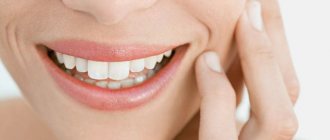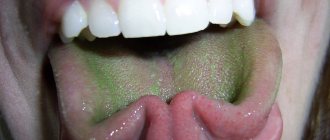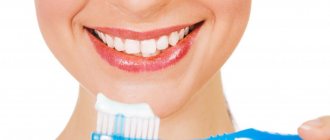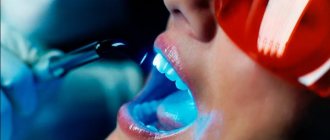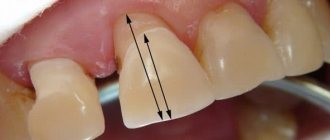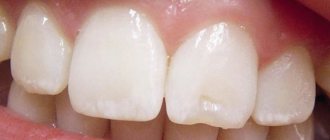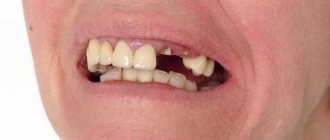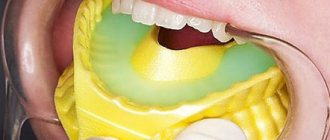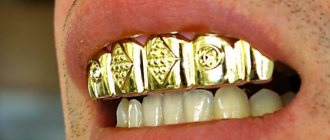Dental deposits are plaque and tartar that form on the surfaces of teeth and accumulate in the supragingival and subgingival space. Dental plaque not only makes our teeth unsightly - dull and yellow, but they contribute to the development of a wide variety of dental diseases of the teeth and gums. It is for this reason that it is imperative to remove dental plaque and do it in the dentist’s office, using professional techniques and equipment.
How dental plaque is removed in dentistry, by what methods and what is the price for the service in Moscow - we will answer all these questions in detail in this article.
What is dental plaque and how is it removed in dentistry?
Dental plaque is plaque that remains on the teeth after eating or drinking. This plaque contains large quantities of various bacteria and pathogenic microorganisms that harm the health of our teeth and gums. If soft dental deposits are not removed by regular brushing, they will gradually harden and turn into stone, which cannot be removed at home. Both hard and soft deposits on teeth increase the risks of developing caries, periodontitis and periodontal disease. Therefore, you need to deal with their timely removal.
Some people think that brushing their teeth every day will be enough to completely remove plaque, but this is not true. Even if you carry out dental hygiene according to all the rules and using all the recommended tools (brushes, brushes, floss), you will still not be able to carry out high-quality removal of deposits from hard-to-reach places in the oral cavity - interdental spaces, in the space above and below the gums. For this reason, to remove dental plaque, you need to go to dentistry and carry out the procedure using professional techniques and instruments.
To remove dental plaque in modern dentistry, various methods are used, and below we will consider in detail the most popular methods of cleaning teeth and the oral cavity from plaque and tartar.
Calculate the cost of treatment by taking a short test in 20 seconds!
Do not delay your treatment, because in this matter time plays against us.
Why do deposits form?
Plaque appears on teeth, first of all, because there is no proper hygiene. Or the person is using the wrong teeth cleaning technique.
Other factors that provoke the appearance of plaque include:
- the toothpastes used do not meet dental requirements;
- the toothbrush is very soft, it cannot cope with plaque;
- brushing teeth with one brush for more than three months;
- insufficient consumption of carrots, apples, and other solid foods;
- the predominance of soft food in the diet, it accumulates more strongly in hard-to-reach places;
- not smooth enamel surface or improperly grown teeth;
- the load on the masticatory apparatus is placed unevenly;
- abuse of bad habits;
- periodontitis is an inflammatory process around the tooth root;
- impaired metabolism due to frequent use of medications.
Improper tooth brushing can cause plaque formation.
All this can lead to deposits beginning to accumulate on the teeth.
Removing dental plaque: methods used in modern dentistry
To remove dental plaque in dentistry, physical and hardware methods can be used. In the first option, special tools are used to remove deposits - stone and plaque - hooks, scalers, finishers. However, the physical method of removing dental plaque is used quite rarely, only when there is a need to remove tartar from deep gum pockets, from which it is difficult to remove it in other ways.
Why has removing dental plaque with hand instruments become unpopular among modern dentists? It's simple, this method is less advanced than modern technologies for removing plaque and tartar. Manual removal of dental plaque is a labor-intensive process, the effectiveness of which will largely depend on the level of knowledge and qualifications of the dentist. Moreover, when manually removing dental deposits, irregularities remain on the teeth, in which plaque will accumulate even more actively.
Due to the considered disadvantages, manual removal of dental plaque is rarely carried out; hardware methods for removing plaque and tartar are more often used - Air Flow technology and ultrasonic cleaning.
Air Flow technology for removing dental plaque
This technology is ideal for removing soft and pigmented deposits from tooth surfaces.
The procedure for removing plaque is quick and without discomfort for the patient and, in addition to removing plaque, it helps to lighten the tooth enamel a little - by approximately 2-3 shades, to its natural shade. When removing dental plaque using Air Flow technology, teeth are cleaned by applying a powerful air-water flow to their surface, which contains abrasive particles (soda).
Air Flow dental plaque removal is an effective and gentle method of combating plaque, but with all its advantages, it does not help get rid of tartar. To carry out high-quality removal of hard dental deposits, teeth are cleaned with ultrasound. We will talk about this technology in detail in a separate section of our article.
Removing tartar using air-abrasive treatment Air Flow
The Air Flow air abrasive treatment method for removing tartar is based on applying a pressurized solution containing water and abrasive substances to the teeth. The doctor applies the mixture to the teeth under pressure, and the surface of the teeth is cleaned of yellow plaque and surface pigmentation as a result of air abrasive treatment. The method is used as an auxiliary procedure after removing tartar using ultrasound. Air abrasive treatment removes its residues located in hard-to-reach areas and ensures grinding and polishing of the enamel. The Air Flow technique can be effective when used as an independent procedure, but only if stone formations are removed in the initial stages.
Ultrasound removal of dental plaque: features, stages and prices
Ultrasound removal of dental plaque is a modern and highly effective method of oral hygiene. Ultrasound will help:
- Carry out the removal of supragingival and subgingival tartar;
- Quickly remove pigmented plaque;
- Eliminate soft microbial plaque.
Removing dental plaque is a procedure that is carried out in three stages. Below we will tell you in detail how the process of removing dental plaque with ultrasound will take place in the dentist’s office.
STEP 1: Ultrasound removal of plaque and tartar
Ultrasound removal of dental plaque is carried out using special equipment - ultrasonic scalers.
Scalers can be either a separate device or part of a dental unit. The main working element of the scaler is its tip with a metal attachment. The tip of this metal nozzle vibrates at high frequencies in the ultrasonic range. Also, water is supplied through the nozzle, which washes away decayed dental plaque from the patient’s mouth and is immediately removed with a saliva ejector.
Free consultation on the cost of treatment in our dentistry
Leave a request and the clinic administrator will contact you within 15 minutes!
The scaler effectively removes dental plaque because:
1. Its nozzle creates oscillatory movements that destroy plaque and tartar. In order for the removal of dental plaque to be carried out efficiently and without damaging the teeth, it is extremely important that the vibrations of the nozzle are directed along the dental surfaces.
2. During the operation of the scaler, water is supplied to the oral cavity, which is needed not only to wash out destroyed deposits and cool the nozzle. Ultrasound in an aqueous environment creates many small bubbles, which immediately burst, releasing a large amount of energy. This energy promotes improved removal of dental plaque from tooth enamel, and in addition, helps eliminate pathogenic microflora in the oral cavity.
After removing plaque, the second stage of ultrasonic cleaning is carried out - teeth polishing.
STEP 2: Polishing teeth after removing dental plaque with ultrasound
Polishing teeth after removing dental plaque is an event that must be carried out without fail.
After removing deposits with ultrasound, microscopic particles of plaque and stone may remain on the dental surfaces, making the tooth enamel uneven and rough, which will provide optimal conditions for the accelerated accumulation of a new layer of plaque. Polishing teeth after removing deposits can be done with hand tools, but most often the Air Flow technology is used for polishing, which we briefly told you about above. When manually polishing teeth, after removing plaque, pastes, brushes and strips are used - thin strips with an abrasive layer, which polish the space between the teeth.
STAGE 3: Remineralization of teeth after removal of plaque and tartar
This stage is not considered mandatory and, moreover, many clinics do not include it in the procedure for professional removal of dental plaque.
However, remineralization must be carried out after removing plaque and tartar from the teeth. It helps strengthen tooth enamel and relieve sensitivity that may occur in the neck area of teeth after plaque removal. Remineralization of teeth is carried out immediately after removing plaque and tartar and uses special preparations based on sodium fluoride.
Advantages of ultrasonic dental plaque removal
Ultrasound removal of plaque and tartar has a number of advantages. First of all, it is worth noting the high efficiency and versatility of the technology: it is ideal for removing pigmented plaque and perfectly removes stone from the most inaccessible areas of the oral cavity, even from deep periodontal pockets.
Removing plaque and tartar with ultrasound helps destroy pathogenic microflora in the oral cavity and, what is especially important, cleans periodontal pockets from pathogenic bacteria.
A clear advantage of removing dental plaque with ultrasound is the affordable cost of the procedure. On average, you will have to pay 4-5 thousand rubles for removing plaque and tartar, polishing and remineralizing teeth.
Price
The cost of preventive oral hygiene treatments may vary from city to city.
Prices also depend on factors such as: the age of the patient, the general condition of the oral cavity and the desired result.
Often, to achieve the desired effect, you have to use several methods, which also affects the price.
But don’t despair, dental clinics quite often hold promotions and discounts on professional oral hygiene, especially for regular customers.
All prices listed are approximate:
- Comprehensive teeth cleaning using ultrasound will cost an average of 5,000 rubles.
- Laser cleaning is a more expensive procedure and costs from 250 rubles. for one tooth.
- Combined cleaning and polishing of teeth using handy blasters will cost from 7,000 rubles. and higher.
It is necessary to clarify the cost of each specific procedure in dental clinics.
To avoid oral diseases, constant hygiene is required. Unfortunately, brushing and rinsing your teeth does not always cope with the formation of plaque and tartar. The most suitable method is recommended by a specialist, according to individual indications, the main thing is to contact him in time.
We suggest you read: Rinsing with soda for toothache and inflammation of the oral cavity, saline solution
Are there any disadvantages to ultrasonic tartar removal?
There are no downsides to the technology of removing tartar using ultrasound - it is the most modern and effective method of professional oral hygiene. However, before you go to the dentist’s office to remove tartar with ultrasound, you should find out the level of competence of the doctor, as well as the level of equipment of the clinic.
Why is it important? The fact is that if the removal of tartar and plaque from teeth is carried out by an inexperienced or illiterate specialist, or using outdated equipment, there is a high risk of damage to tooth enamel and poor quality of cleaning them from deposits.
Causes of plaque formation
The main reason why plaque forms in the mouth is the large number of microorganisms living in the mouth. The danger of these bacteria lies in the fact that they can grow and multiply quite quickly. After a person has thoroughly cleaned his teeth, after two hours a thin film, called plaque, begins to appear on the surface of the tooth.
The formation and reproduction of bacteria parasitizing in the oral cavity is influenced by the following factors:
- Eating large quantities of foods containing light carbohydrates, such as sweets, candies, and baked goods.
- Frequent consumption of coffee or tea containing the same light carbohydrates. When consuming these drinks, plaque forms and dark marks remain on the edges of the teeth near the gums, which leads to the rapid onset of the first phase of plaque accumulation.
- Smoking is the main reason for the rapid formation of plaque on teeth. If a person is addicted to smoking, then he needs more careful oral care. The resin contained in nicotine contributes to the formation of brown plaque on the surface of the tooth, and, as a result, a lot of bacteria accumulate in the oral cavity. Nicotine has a detrimental effect on dentin and destroys it, causing tooth enamel to darken. If you do not take care of your oral cavity, then with constant smoking, your teeth will very quickly become black or dark brown and will be destroyed in a short time.
- Improper and irregular oral hygiene is the cause of plaque formation. If you forget to brush your teeth, the soft plaque will become hard, forming a stone. It can only be removed in the dentist's office.
Plaque also forms when chewing is insufficient, during sleep, hyposalivation, xerostomia, when eating foods high in protein and low in fat, and taking iron supplements.
How to preserve the results of dental plaque removal for a long time?
In order for the positive results of cleaning to last for a long time after removing plaque and tartar, you need to learn how to properly care for your teeth. Here are the recommendations that dentists give to their patients:
- Choose and use in dental and oral hygiene the brush and paste that suits you - your type and condition of tooth enamel;
- Brush your teeth at least twice a day - before breakfast and before bed. Try to rinse your mouth after every meal; • Brush your teeth in a circular motion for 3-5 minutes;
- Use rinses and dental floss to remove plaque from interdental spaces and other places in the mouth that are difficult to clean with a regular brush;
- Teeth need to be brushed from all sides, in addition, the tongue and gums need to be cleansed;
- Try to drink coffee and tea less often, and it’s better to quit smoking altogether. It is these habits that contribute to the rapid formation of pigmented plaque.
And of course, don’t forget that professional dental plaque removal is a procedure that should be carried out at least twice a year!
What you need to know about tartar?
There are 2 types of dental calculus: supragingival (it can be easily detected by a specialist during an initial examination - it is located above the gingival margin, has a yellowish or white color, can be clay-like or hard), and subgingival - very dense and hard, dark green or brown color, a special probe is used to detect it. The first type can occur in people of completely different ages, and the subgingival type can occur in patients over 40 years of age.
Important! The formation of tartar is caused by improper brushing of teeth, insufficient amounts of solid food, use of an outdated brush, improper distribution of the chewing load, and metabolic disorders (especially salt).
There are several methods for removing this type of plaque :
- Ultrasonic. A special scanner is used for this purpose. It removes visible and hidden deposits, as well as any bacteria. In places with thinned enamel, the patient may experience pain. They give local anesthesia there. This removal method is considered the most common.
- Mechanically. The main tool is a special bur. The doctor lifts the stone, separates it from the tooth, and scrapes the surface. This method is not considered ideal, since it is impossible to remove the stone under the gum, and the patient may experience pain. Currently, such cleaning is rarely carried out.
- Laser. The most gentle method. The laser beam acts on dental plaque, removing plaque layer by layer. In this case, the stone is crushed into small particles, and then removed from the mouth with a stream of water and air. The patient does not feel any discomfort; painkillers are not required.
- Chemically. Special pastes or gels containing alkalis and acids are applied to the teeth. They effectively act on the stone, soften it, and then it is easily removed. This procedure also does not cause pain, but it has disadvantages: it is impossible to completely get rid of deposits, and alkalis and acids can damage the gums and enamel.
Important! Ultrasonic cleaning is prohibited for adolescents and children during the period of change of bite, patients with orthopedic structures and implants, people with asthma, chronic bronchitis, arrhythmia, with dental hypersensitivity, in the first trimester of pregnancy. In these cases, the doctor selects other options depending on your medical history and health status.
Many dentists use several of these methods simultaneously to obtain quick and effective results. After removing plaque, the specialist polishes the teeth (plaque accumulates on a smooth surface much more slowly than on a rough surface). At the end, a fluoride-containing gel is applied to them to consolidate the result. With the correct selection of the method, complications occur extremely rarely.
Is it harmful - ultrasonic removal of dental plaque?
Many patients are interested in the question of the safety of ultrasonic removal of dental plaque. We hasten to reassure you - the safety of the procedure has long been proven and confirmed by a number of clinical studies. The use of ultrasonic equipment to remove plaque and tartar from teeth does not cause any negative side reactions or pathological changes in the human body.
However, it is worth considering that there are a number of contraindications to the procedure that must be taken into account. Ultrasound removal of dental plaque should be avoided if you have serious pathologies of the heart and blood vessels, severe respiratory diseases, pathological tooth sensitivity, and ultrasonic teeth cleaning is not performed in children and adolescents.
During pregnancy, it is possible to remove dental plaque with ultrasound, but not in the first trimester.
Calculate the cost of treatment by taking a short test in 20 seconds!
Do not delay your treatment, because in this matter time plays against us.
Cost of dental plaque removal
We have already written above that this procedure has a cost that is quite affordable for a wide range of patients. But in different clinics the price may be different: this is explained by the fact that different dentists include a different set of procedures in the dental plaque removal service. Most often, a complex is offered that includes ultrasonic teeth cleaning, Air Flow polishing and fluoridation. The cost of such a comprehensive service in Moscow will start at 4,500 rubles.
You can undergo the procedure for removing dental plaque in comfortable conditions and using ultra-modern technologies and equipment in our dental clinic in Moscow - VENSTOM. You can find out all the details about the service and about making an appointment with our specialists by writing to the chat on our website or calling us!
